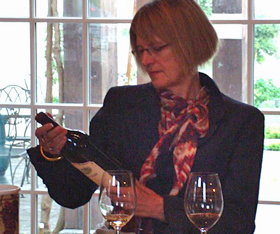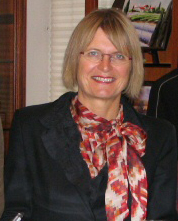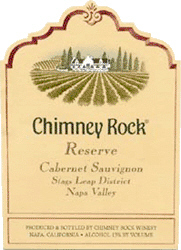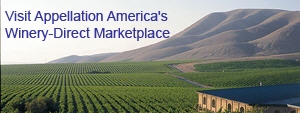

Wine journalist Jancis Robinson came to Chimney Rock Winery in Napa Valley to promote her new books but got into an exclusive discussion with Appellation America on other topics.
Why Many Sub-AVAs Don’t
Show Up on Wine Labels
Jancis Robinson, the acclaimed author of the exhaustive "Oxford Companion to Wine" and "The World Atlas of Wine", says many wineries believe they get more consumer recognition by NOT putting sub-AVAs on the front label.
by
Alan Goldfarb
November 5, 2007
 bout five years ago, when APPELLATION AMERICA was in its infancy, I remember a discussion with publisher Roger Dial, which centered on the topic of why vintners seemed loathe to place sub-regional names on their labels. Over bowls of pasta and various glasses of wine, the conclusion was that having “Napa Valley” on one’s bottle carries far more cachet and importance than does, let’s say, “Wild Horse Valley” or “Chiles Valley.”
bout five years ago, when APPELLATION AMERICA was in its infancy, I remember a discussion with publisher Roger Dial, which centered on the topic of why vintners seemed loathe to place sub-regional names on their labels. Over bowls of pasta and various glasses of wine, the conclusion was that having “Napa Valley” on one’s bottle carries far more cachet and importance than does, let’s say, “Wild Horse Valley” or “Chiles Valley.”
In the Napa Valley recently to peddle her latest editions of “The Oxford Companion to Wine ” and “The World Atlas of Wine ” (co-authored with Hugh Johnson), Jancis Robinson wonders the same thing: Why aren’t we seeing more sub-appellation names appearing on wines?
“I had a discussion with Bill Harlan (Harlan Estate) when he was starting BOND (the Oakville-based winery), which is dedicated to single vineyard wine(s). He said he wasn’t going to put sub-appellations (on his labels),” Robinson tells me in the conference room at Chimney Rock Winery, where she had just finished a breakfast discussion with a group of wine writers.
“I don’t see why (not),” the British writer continues, “I thought it (promoting sub-AVAs) would educate the people. Is it a habit or did it spring out of not wanting to talk about the grower?”
 Truth be told, placing American Viticultural Area (AVA) names, as it pertains to sub-zones, is becoming more prevalent (the TTB’s temporary embargo on the practice of naming additional sub-AVAs notwithstanding). Several areas in the Napa Valley have been practicing AVA placement for years, i.e. Howell Mountain, Diamond Mountain, Mount Veeder, Spring Mountain, Rutherford, Oakville, to name but a few.
Truth be told, placing American Viticultural Area (AVA) names, as it pertains to sub-zones, is becoming more prevalent (the TTB’s temporary embargo on the practice of naming additional sub-AVAs notwithstanding). Several areas in the Napa Valley have been practicing AVA placement for years, i.e. Howell Mountain, Diamond Mountain, Mount Veeder, Spring Mountain, Rutherford, Oakville, to name but a few.
The vintners from these regions obviously see the value in putting sub-AVAs on their labels as some sub-appellations begin to discern real or perceived terroir differences beyond the original marketing and geo-political raison d’être that established them in the first place.
Additionally, by law, if one opts to place the sub-AVA on their label, the name of the over-arching AVA has to appear as well. Which means there’s nothing to lose because the rubric “Napa Valley”, most likely printed in a larger, more visible font, will still predominate and shout.
To Jancis Robinson, one of the most well-known and respected wine journalists in the world, placing the name of the sub-region on a label is tantamount to breathing air.
“Labeling of sub-AVAs? That’s a bee in my bonnet. I don’t know why more producers don’t put the (sub-AVAs) on their labels,” says Robinson quaintly. She is dressed smartly in a cinched black hip-length jacket pulled in with a wide-buckled burgundy belt, which covers tight-fitting satin black pants tucked into black patent leather man-tailored shoes.
Robinson goes on to tell APPELLATION AMERICA, “There’s no doubt various parts of the Napa Valley are different.” She cites two such areas: Rutherford, which has “sturdy, more earthy” wines; and the Stags Leap District , which she refers to as having “aromatic potential.”
She also describes the two regions as having “Bordeaux similarities” with Rutherford; having
 intense qualities as does Château Latour; and alludes to the Stags Leap wines as being similar to Château Margaux. (As a point of reference, the Bordeaux properties are in the Médoc, with Latour residing in the southeastern tip of Pauillac and Margaux in the central part of the region. Rutherford is located in the center of the Napa Valley, while SLD is in the southeast.)
intense qualities as does Château Latour; and alludes to the Stags Leap wines as being similar to Château Margaux. (As a point of reference, the Bordeaux properties are in the Médoc, with Latour residing in the southeastern tip of Pauillac and Margaux in the central part of the region. Rutherford is located in the center of the Napa Valley, while SLD is in the southeast.)
When the subject changes to a question regarding the growing notion of fruit forward wines with high alcohol as being wines that are unbalanced, Robinson says to me, “That’s a charged question.” Nevertheless, she then goes on to express some of her feelings, although she does so guardedly.
“I’m keenly aware that winemakers struggle to get sugar and phenolics (flavors) closer together,” she says, describing the reason for the practice of long maturation on the vine or “hang time.” Most of them don’t want to make unbalanced wines. The phenolics are slightly riper (now) and chewy (but) I don’t think they have to be super sweet … Chewy-ness is quite digestible and a slight whiff of herbaceous-ness (which winemakers try and eschew at all costs), can be quite refreshing.
“But sometimes the ripeness is taken to unnecessary limits (and) the wines do taste sweeter than French wines. (And) the U.S. market seems to depend very, very heavily on media scores.”
Even the highly regarded Robinson, who does not assign scores in her various writings, nonetheless, has taken to giving scores to reviews on her Web site (jancisrobinson.com - paid subscription only). However, she tells me, “I do so reluctantly.”
And Robinson admits, “Wine doesn’t submit very happily to scores, but I realize people making buying decisions are in a hurry … We live in a very impatient age.”










 READER FEEDBACK: To post your comments on this story,
READER FEEDBACK: To post your comments on this story,



